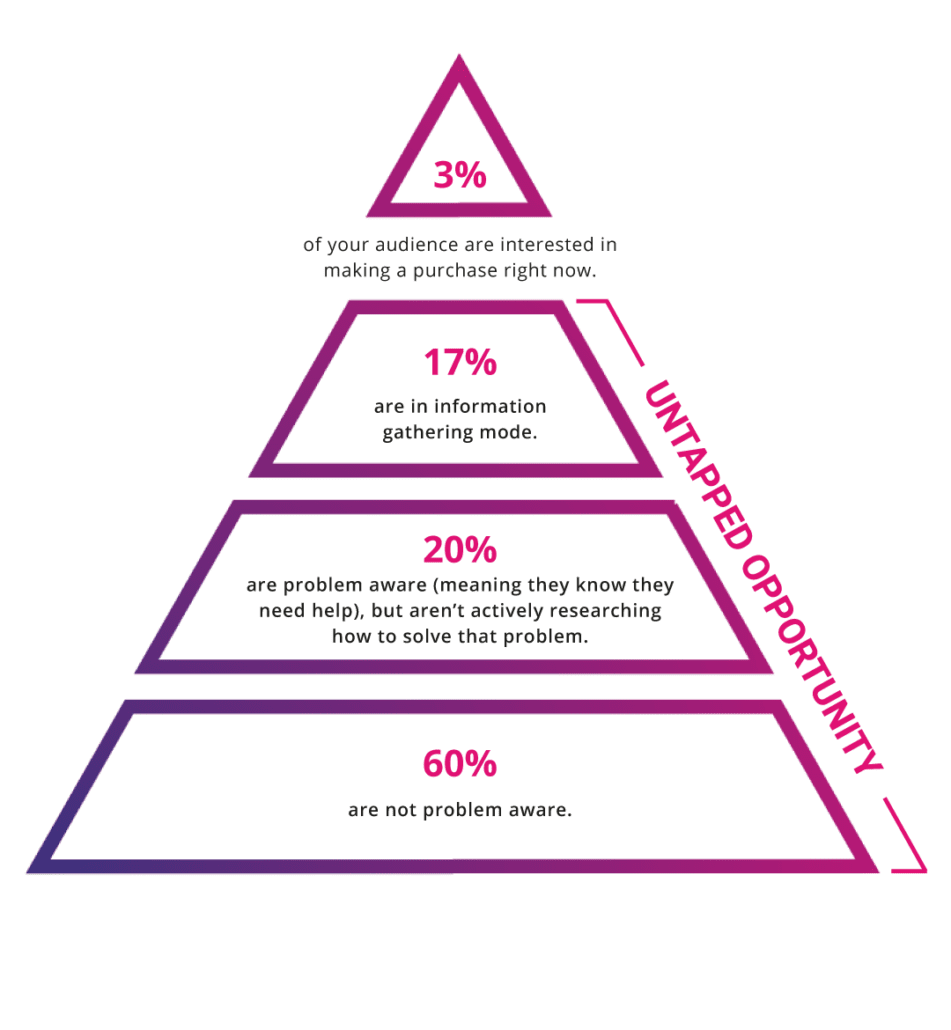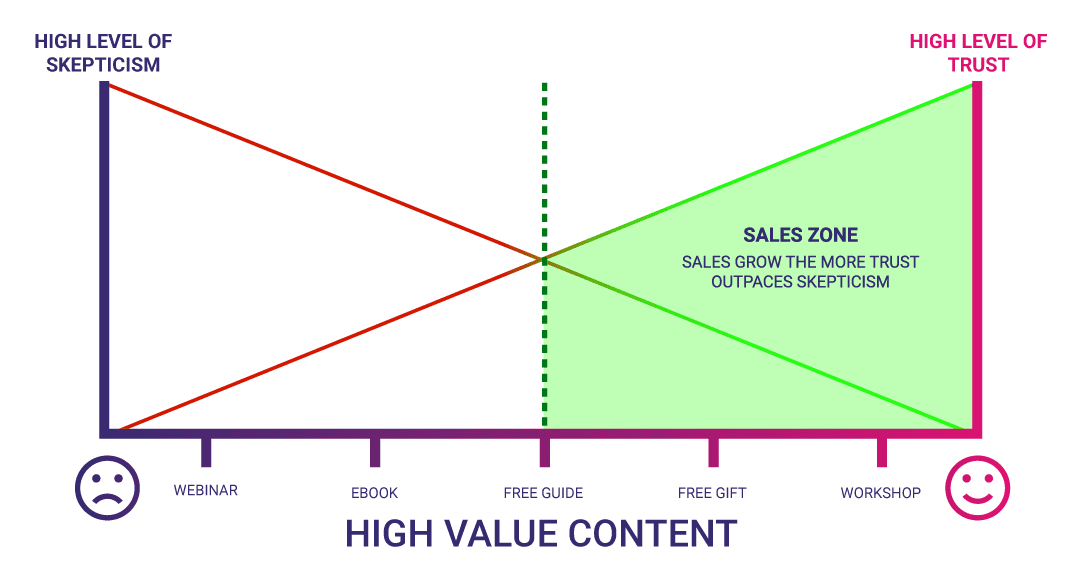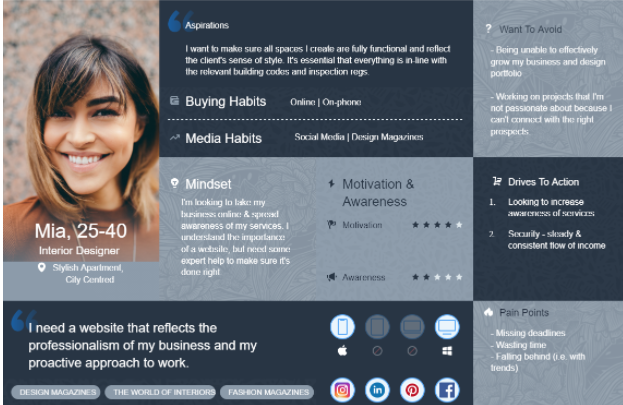In this day and age, digital marketing is one of the most impactful ways to grow your business. Whether you focus on building awareness, lead generation or getting people to take action such as making a purchase, downloading a guide or getting in touch – there is nothing else that has the same potential as digital marketing for helping your business grow.
For years we’ve been selling products and services online, from free ebooks to high ticket services. This article has been designed to give you an idea of what you can do to help your business grow through digital technology.
This post is designed to give you a high-level grasp and will give you a great foundation for selling your products and/or services online. Each section will be supported by more specific content that goes into more detail.
So, grab yourself a drink, get your notepad ready and let’s dive in.
How To Recognise Opportunities In The Market
With digital marketing, it isn’t about diving headfirst into it. Time needs to be spent planning things out, researching and developing a strategy that reflects the insights that you have gained – if you don’t do this then there’s a chance you’ll miss out on masses of potential custom. Before taking things further there is one key concept you truly need to understand to see how much potential there actually is in your marketplace:
The 3% vs 97% ideology.
At any given moment approximately 3% of a marketplace is looking to buy right now. This is the smallest percentage of the market, yet it is the segment that everyone focuses on advertising to.
So while you’re trying your best to get your business’s voice heard through all the noise of the market, every competitor that you know of (and more!) are doing exactly the same thing.
This leads to an oversaturated marketplace and prospective customers potentially not recognising or even acknowledging an advertising message.
In contrast, very few businesses are noticing all the potential and opportunity that remains in the other 97%.
These are the people who might not be ‘ready to buy’ at this very moment, but that doesn’t mean that they won’t prove to be valuable to your business in the long run.
This 97% can be further broken down into these categories:
- 17% – are in information-gathering mode
- 20% – are problem aware, but aren’t actively researching for a solution
- 60% – are not problem aware
This is the 97% you are missing out on. The people who are in the pipeline towards that competitive pool of the top 3% buyers.
By acknowledging them before they hit this peak point, you have the chance to provide them with value before they move on to buying.
To do this, you need effective nurturing strategies that involve creating content that is designed to educate the consumer on what problem you solve and how you solve it. In addition to this, you also need to showcase the value you can provide to them through what you do – i.e.:
- You make their lives easier
- You save them time
- You save them money
All of this is key towards making people comfortable with the idea of your business and what you can provide. This is important because it shows you care about nurturing a relationship with your customers rather than getting a one-off sale.
Red Ocean Vs Blue Ocean – How This Relates To Your Market
So first of all, what is the difference between a red ocean and a blue ocean and what does this mean for your business?
Well, the red ocean strategy is the idea of competing in a high-intensity marketplace, overflowing with other businesses and limited demand from your ideal customers.
In other words, it is near impossible to break through all that noise.
Meanwhile, the blue ocean strategy is the complete opposite, giving your business the potential for growth in a new pool of potential. An ocean of market space where there is limited competition and plenty of opportunity for connecting with customers in a new and unexplored way.
To unlock this opportunity in a new marketplace, you need to open the floodgates to this newfound demand. This is achievable by looking beyond what your target audience is asking for, and seeing how you can give them even more.
How Scepticism And Trust Impact Your Business
If you want to get higher quality leads at a lower cost and to give your conversion rates the boost it needs using low-risk offers, then you need to be aware of how you can build a bridge between scepticism and trust.
When you turn your attention to building up relationships with prospective customers, it’s time to identify how you can consistently provide impactful value to that 97% of the market to get bigger deals with better buyers.
The starting point is when a prospective buyer has very low trust and high scepticism – they are not ready for a relationship with you or your business. With the right steps that effectively accommodate their needs, you can guide them towards a position of trust.
The trick to this is knowing where to place your efforts. When it comes to building up a relationship between your business and prospective customers, you need to establish how you can build up that trust – what can you offer people to give them more confidence in your business and what you provide.
If it helps, view your business as a relationship, you wouldn’t propose to someone 5 minutes after meeting them, so why are you trying to sell to people the minute you meet them?
Instead you need to offer a small step to start building up that trust and decide what value you’re willing to offer people from the get-go – i.e. a free eBook, a video tutorial, a walkthrough of how to use a piece of software?
Here is a visual example to demonstrate what we’re talking about:
You need to work to take people from that initial awareness phase and provide them with value throughout the customer journey. Plan out the stages of your funnel, the journey that you want to take prospective customers on when they work with your business – from awareness to conversion. Figure out where your big-ticket items are and how you can help to draw in a flow of high-quality leads towards these products/services and then use high-value content to get into the green Sales Zone to start making more money for your business.
The Discovery Phase Of Business Development
If you want your business to grow then you must be aware of what your competition is doing as well as how the overall market is changing – the key being to keep an eye out for the trends that you can capitalise on. It’s all about knowing what opportunities are available, where your business fits into those and it’s vital if you want to get ahead in your industry.
Research plays a pivotal part in the process of growing your business – you need to understand the market trends, how it’s changing and who is driving new demand. To start with, you will need to identify the trends that you can connect with – what are they and what opportunities are available for your business?
Each of these questions will help develop an effective plan for research and discovery into what’s happening with the market. After you have gathered this information, you can see how you can grab prospective customers’ interests – i.e. because you’re being responsive to them and their issues.
Take the time to look into your marketplace and analyse what you can see, some things to keep an eye out for:
- Do you know what specifically is happening in the industry?
- What do your prospective customers want?
- What problems are they having?
This is an example of a high-value task, having an awareness of this is key to the future development and growth of your business and being able to put a plan of action in place that can get your business great results.
Recognising The Difference Between High & Low-Value Tasks
Before diving into the marketing side of things even further it’s important to see the connection between your approach to low and high-value tasks and how your business effectively develops and grows.
- Low-Value task – a task that isn’t helping drive towards business growth, something that sucks up a lot of time and energy but doesn’t have any great beneficial pay-off.
- High-Value task – something that is going to help your business develop and progress, this should be on the top of your priorities list and something that you refer back to frequently to help your business grow.
Focusing too much on low-value tasks means one thing – your business’s growth is being restricted which means you’re not maximising on opportunities for revenue generation, expanding your workforce, developing the skills of current employees or connecting with the right pool of clients.
In other words, the real high-priority tasks are taking a back seat. Here is some real-life context: if you’re a company director and you’re having to regularly deal with small team squabbles then you’re focusing too much on a low priority task – basically, something that is taking up your time and energy but is doing nothing to drive forward your business’s development. Instead, this ongoing issue is just going to be a drain on all the time and resources you could have spent investing in the growth strategies that can help your business grow.
If this sounds familiar then it’s time to take note of how long these smaller tasks are actually taking you. Identify the things that are stopping that big picture from developing and see how much time this takes up in the average day, week or month for you (hint – it might be much more than you’d think).
So how can you manage these issues? By allocating these low-value tasks to someone else, for example, if we use the team squabbles issue again, you can hire a Human Resources manager who is responsible for handling these issues.
Working With The Wants & Needs Of Your Customers
Do your clients leave you raving reviews on how MUCH you’ve helped or does your sales pitch always result in you bargaining?
If you don’t listen and understand the wants and needs of your target audience then you won’t be able to effectively market to them and there’s a high likelihood that they are going to look elsewhere as they have no reason to be invested in your offer. Ask yourself this – was your offer really created with your ideal prospects in mind?
Recognising that you need to build your offer around the wants and needs of your target audience is a vital step to making sure that your business has a strong foundation that will ultimately help you grow your revenue over the long term.
Start looking into the feedback current clients and prospects are giving you – i.e. see what attracted them to your current offer. Look outside of your business, for example, view online groups related to your industry, acknowledging not just people’s wants and needs but their pain points too. Take the time to understand the marketplace, what your customers are looking for and how you can mould your offer and marketing strategy to reflect this.
Ask yourself some difficult questions:
- Do you know who your ideal customers are, and who you are crafting your offer for?
- Is there currently high uptake in your offer?
Developing A Perfect Client Persona
A persona is the idea of the type of client that you’d like to work with, so to help you better market to your audience, you need to create a fictional perfect customer, so assign them a few details – i.e. an ideal age range, location, occupation (etc) to nail down a few basic characteristics.
This allows you to drop off interest with any potential customers who aren’t a good fit for what you have to offer – meaning that the time, money and energy that you invest is still targeted towards those people who will have an interest in what your business is able to do for them.
Think about how different each client is and how their wants and needs are completely unique, by using personas you will be able to build an offer around this. Ensure that you have personas set up for your business, make sure to identify: their wants/needs, their pain points and what barriers and uncertainties block them from buying from you.
This is key for ensuring that the offer you develop is fitting of this perfect persona’s needs and makes it more likely your business will make a sale because every time you are creating a piece of content, you are doing so with this ideal persona in mind. Here is an example of a visual board created to reflect the perfect persona for an Interior Designer looking to set up a website for their business:
How Does This Help You Connect & Engage With Your Dream Clients?
How you present your business to your prospects is something that will stick in their mind and can impact whether they decide to buy from you or not. Connecting with the right pool of prospects takes dedication and a willingness and ability to research their wants and needs in-depth. If you want to succeed then you need to keep your finger on the pulse when it comes to being responsive to their requirements and offering your product/service as the solution to their problems.
Development of the ideal client model gives you a starting point as whenever you are developing content, considering introducing a new product or are looking to modify your overall strategy this is a resource that you can always refer back to. This can help to keep your marketing message consistent and focused on the right people, but it isn’t the only thing that you can do to ensure you’re reaching out to the right people.
Here we’ve compiled a brief list of what else you can do to keep ahead of the game:
- Monitor Market Trends – you can keep up with the latest in your ideal customer’s lives is by staying on top of the latest trends and changes as they develop in your marketplace. These changes can potentially have a knock-on effect on your customers’ wants, needs and expectations from businesses like yours. To ensure you never miss a thing, assign a team member or third party to monitor these trends for you, giving you an overview of key information to help you make more strategic decisions.
- Modify Your Offer Accordingly – As we’ve already said, changes in the marketplace can have an effect on what they need from your business, so if uptake in your offer ever levels off or drops off significantly, it’s time to regroup and recognise what needs to change.
- Experiment With Your Marketing – If you haven’t already, introduce automation into your business – i.e. email automation that can allow you to continuously nurture prospective customers, so no matter what you’re consistently popping up in their inbox with some value to add.
By taking the time to understand what people need from your business, you are better able to cater to their needs and provide them with something that they’ll actually find value in, meaning that when the time comes to buy, your business is a natural first choice.
Perfecting Your Offer To Engage With Clients
When you are working on developing an offer, you need to make sure to clearly outline how this will have a direct impact on a prospective customer’s pain points – but it’s something you have to do gradually.
Starting off by claiming your business can solve all of life’s problems can lead to high scepticism amongst your ideal buyers, so significantly less uptake in what you’re offering. If you want people to acknowledge what you’re offering you need to set out stepping stones to build up to this higher ticket item.
By crafting an offer that shows that it solves the pain points of your perfect personas, you are far more likely to encourage them into action with what you’re offering – meaning further leads and sales for your business.
A High-Value Content Offer (HVCO) can be a great way to draw in your ideal prospects with an offer that they simply can’t ignore.
To make a HVCO that can’t be missed, you need to touch on something that holds relevance to them, capturing their attention and making them want to know more.
- Referring back to your perfect personas, understand how this research ties in with the offer that you’ve crafted.
- Based on your research and historical data, create some drafts of offers, or look at what you currently have and see how segments of your target audience respond to it – this can help you to see if you are crafting something which has a real impact and is effective.
- Value Ladder / Hierarchy of offers – focus on selling the next step in the journey rather than trying to achieve the end goal immediately.
Prioritising Top-Level Strategy Over Day-To-Day Tactics
Too often business owners get consumed with the ideas of tactics that take up far too much of their time and effort in any given day – this is surface-level work that doesn’t really dig deep into your business-wide strategy, hindering your business’s growth and restricting your ability to generate profit.
An example of this can be admin emails, you’re working through a never-ending cycle – this is something that 100% needs to be done, but not necessarily by you. These types of tasks can be delegated to someone else on your team to manage, so you’re not neglecting email communication you’re just giving yourself more time to focus on the big picture.
If you want to stop focusing too much on tactics at the expense of your strategy then you need to invest time in understanding what your unique value proposition is.
“What is a Unique Value Proposition?”
Also known as a unique selling point, this is something about your business that makes it unique from its competitors, something that makes your business stand out in a crowded marketplace and shows people why they should choose your business over others.
Identifying these unique aspects can play a key role in the development of your business strategy. To help you get started, here are a few key points to keep in mind:
- Are you focusing on a particular market segment?
- Targeting specific characteristics of your ideal customer?
- What channels of communication are your target audience active on?
- Which of these platforms can/will you use?
With the right setup, you’re in a better position to develop a system that is truly unique to your business and will help you to connect with prospective customers on a whole new level, introducing them to something about your business that will make their lives easier, days better, be more productive – the benefit associated with your USP needs to be crystal clear to your prospects to help you draw in those high-quality leads into your funnel system.
The Digital Development Aspect
There are various elements that go into the digital side of your overall business plan. To give you an idea of what needs to be taken into consideration to take all you’ve learnt from customer research right through to your offer development, we’ve compiled a few bullet points and outlined how they can be useful to your business.
-
Funnel
A funnel allows you to map out the journey that you want prospective customers to take when they begin to engage with your business, starting off from the initial interaction right through to becoming a loyal customer.
- Identify Stepping Stones In Your Funnel – this is creating the path towards your high-ticket sales item, guiding people from that initial point of contact towards making a purchase.
- Remarketing – your funnel isn’t just useful for making that initial contact and working towards a sale, it is also useful for reconnecting with people who have previously visited your website using remarketing ad campaigns.
Having an understanding of what stage your prospective customers are at in the funnel is important because it means that you can better market to them according to the point in the customer lifecycle they are in.
Setting up funnel pages that you can use to guide user experience – i.e. you drive traffic to this specific landing page that is tailored around your offer, rather than a generic webpage/homepage which may not entirely align with the message of your ad.
-
“YOU” Focussed Copywriting
If you want to ensure that you get maximum conversions at every stage of your funnel, then “you” focused copy is vital. People have an interest in how your offer will affect them – how it’s going to improve their lives, rather than all the features of what is exactly involved.
It’s key to gain an understanding that there is a difference between a feature of what you can offer and the benefit of this to a user – i.e. you might be able to offer a product that has triple output when compared to the competition, so your target audience needs to understand why this is beneficial for them – i.e. you will be able to produce 3x the amount of flyers to advertise your business.
To do this effectively you need to take stock of the current tools and resources that you have available to you and decide whether this is something you’re going to have an employee work on in-house or whether you are going to hire a professional copywriter to take on this responsibility.
-
Advertising Channels
After all the hard work and effort you have put into understanding your ideal customers and developing your offer to reflect that, it is important that you choose the right advertising channels for your business to advertise on.
Look into the advertising channels available to your business, understand that by having multiple avenues of advertising open you are diversifying your business’s risk – i.e. if one channel goes bust, you have another to rely on. To give you a general idea of what platforms you can start advertising on, we have a list:
- Google Ads
- Google Shopping
- Facebook Advertising
- Instagram Ads
- LinkedIn Paid Advertising
To make your decision easier it is important to refer back to your ideal client model because the advertising channel you choose needs to be one your target audience is active on as if the prospects aren’t there then your advertising isn’t going to reap great rewards.
Once you have selected your advertising channels you need to make sure that the ads you are creating grab people’s attention and make them want to clickthrough to learn more about your offer (depending on what type of campaign you have set up, the offer you make will differ). To put it in general terms you will need to use a powerful combination of eye-catching design and persuasive copy to draw people in.
-
Marketing Automation
This involves using automation to help streamline marketing work and reduce the time spent on repetitive tasks, limit human error and also provide a more personalised experience for prospective customers. Marketing automation software can be a real timesaver and investing in the right systems can ensure you systematically provide value to your prospects, showing your business as a reliable source of information as you start drip-feeding people with higher quality content.
This software can also help to fill up your sales pipeline with ready to buy leads who are interested in your offer and the value that it can have for them. Introducing a nurture automation system can help to raise people’s trust while simultaneously lowering their scepticism too as you are consistently keeping in contact with them, not always pushing for the sale and are providing them with free content/value that is of use to them.
To give you a brief insight into some of the options available to you if you are looking to get started with the digital side of things we’ve listed a few:
- Email Marketing: Active Campaign
- Online Visibility: SEMrush
- Web Analytics: Oribi
-
Email Marketing, CRM & Automation
To effectively communicate with your dream buyers at scale, automation, email marketing and customer relationship management are a major part of this.
Customer relationship management is a necessary tool for any business looking to grow, and to make this a reality, it is important that you have the right tools and resources in place to help your business to advance and grow, while also building up strong relationships with your customers.
Email marketing can play a key part in this nurturing process, as it allows you to have a set point of contact with prospects, helping to keep your business in mind as they move towards making a buying decision.
For example, Active Campaign can create a branch of outreach between your business and prospective customers without having to barely lift a finger after the initial set-up.
-
Web Design & Development
Once you have got your research done and dusted, your offer developed and your ad campaigns up and ready to go, it’s essential that you have got the website side of things to where they need to be too.
-
- Fully Responsive Landing Page & Funnel Design
Simplifying user navigation is a big part of improving user experience while they are on your website – i.e. the easier your website is to use and move around, the more likely it is users will stay on the page longer. To ensure this, you need to set up a logical flow when it comes to your funnel design – so that when users journey through it, they have an understanding of your process and how this can benefit them.
To provide the best experience possible, your website must be optimised to be viewable across multiple devices. This is something to keep in mind when it comes to the digital side of constructing your offer – you need to make it as simple as possible for people to:
- Sign up for your newsletter
- Download your ebook
- Buy your product
-
- On-Page SEO
When it comes to the organic side of things, you need to pay attention to on-page SEO – now this has 101 components which we won’t go through here.
To put it simply, if you want to rise in the ranks of the Google search results, you need to make sure you are developing content that fits within SEO guidelines, and is relevant and engaging for your target audience to read (so no keyword stuffing!).
Whether you’re looking into link-building, optimising your use of keywords or just generally elevating your SEO, it is important to ensure you understand what changes you’re making and why.
Measure What Matters To Your Business
You’ve done the bulk of the hard work, now you just need to make sure to measure your success so you can tell whether you are on the right track or need to make some changes.
Analytics helps businesses to measure key performance indicators (KPIs) that measurably affect their business, and then use these to determine how successful their digital marketing strategy is performing.
Tools like Google Analytics and Oribi can help you to keep on top of all the latest developments and show you how well people are interacting with your marketing and funnel pages – this is key for future optimisation.
Thanks for reading! We hope this blog has given you a clear picture of what digital marketing could mean for your business, whether what you provide is based on or offline.
No matter what industry or niche you’re in, it’s important to make sure you’re taking steps to get your business’s voice heard in the marketplace, and hopefully, this guide has given you an idea of the steps you need to take to make this a reality.





